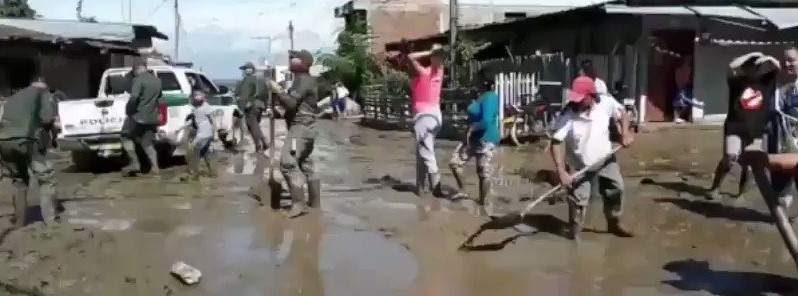At least 4 dead, 18 missing after major mudflow hits Corinto, Colombia

A devastating mudflow swept through Colombian town of Corinto Tuesday afternoon, November 7, 2017, killing at least 4 people and leaving 18 others missing. A total of 29 people were injured and 22 houses destroyed.
The mudflow struck the mountainous town at about 17:30 local time, after the La Paila river burst its banks and sent mud, branches, and boulders through the center of Corinto (population 12 153). The government confirmed 4 deaths and 18 missing people. At least 29 people have been injured and 243 families affected.
Landslides expert Dr. Dave Petley said the mudflow struck during a period of heavy rain. "Fortunately, it appears that a warning system allowed many residents to escape the flow," he said.
The alert was sounded in the town's center before 18:00 local time, allowing many residents to run to safety. Locals, however, argue the warning came too late.
President Juan Manuel Santos stressed out that had the early warnings not been activated, the magnitude of the disaster would have been greater. Santos said firefighters had been deployed from the city of Cali to help residents of the affected area, adding that humanitarian aid would be provided and the scale of the damage would be assessed.
According to the Institute of Hydrology, Meteorology and Environmental Studies (IDEAM), the accumulated rainfall in the region between Tuesday night (November 7) and the dawn of Wednesday (November 9) exceeded 150 mm (5.9 inches).
#Chuva forma cabeça d’água em #Corinto, #Cauca, #Colômbia (07/11/2017) (Crédito: Divulgação/Corpo de Bombeiros) pic.twitter.com/uUTrYNIF0f
— De Olho No Tempo (@deolhonotempo) November 8, 2017
#Chuva forma cabeça d’água em #Corinto, #Cauca, #Colômbia (07/11/2017) (Crédito: Divulgação/Corpo de Bombeiros) pic.twitter.com/Gl2x4QgMDB
— De Olho No Tempo (@deolhonotempo) November 8, 2017
#Chuva forma cabeça d’água em #Corinto, #Cauca, #Colômbia (07/11/2017) (Crédito: Divulgação/Corpo de Bombeiros) pic.twitter.com/REvCdUJfyj
— De Olho No Tempo (@deolhonotempo) November 8, 2017
#Chuva forma cabeça d’água em #Corinto, #Cauca, #Colômbia (07/11/2017) (Crédito: Divulgação/Corpo de Bombeiros) pic.twitter.com/1M4tIPiNZH
— De Olho No Tempo (@deolhonotempo) November 8, 2017
#Chuva forma cabeça d’água em #Corinto, #Cauca, #Colômbia (07/11/2017) (Crédito: Divulgação/Corpo de Bombeiros) pic.twitter.com/RNIuC1zqK0
— De Olho No Tempo (@deolhonotempo) November 8, 2017
Nov8 5pm Lluvias fuertes en algunas zonas del país durante la tarde de hoy. Se mantiene un incremento en la saturación de los suelos, por lo cual persisten alertas por crecientes súbitas y por amenazas de deslizamientos @UNGRD @DefensaCivilCo @DNBomberosCol #NoBajarLaGuardia pic.twitter.com/0UcCba0X9w
— IDEAMColombia (@IDEAMColombia) November 8, 2017
Corinto in Colombia: first @planetlabs satellite images of the mudflow that has killed 4 and left 18 people missing: https://t.co/6L6oY537Tw pic.twitter.com/Tp7f0aFXOb
— Dave Petley (@davepetley) November 9, 2017
El Tiempo reported it was one of the most critical emergencies that Corinto has experienced in its history, because, although it's not the first time that the waters of La Paila river devastate everything in its path, this time the mud reached almost a meter high (3.3 feet) and entered town's center. The two previous floods occurred in 1990 and 2010.
Corinto sits at the foot of one of the country's Andean ranges in Cauca province.
Landslides are common in rural, mountainous areas of Colombia, especially during wetter parts of the year and this is just the most recent deadly landslide to hit the country. The most recent large event at Mocoa, in April 2017, left more than 300 people dead. In May 2016, a mudflow and Salagar in Antioquia killed at least 63 people.
"There are notable similarities between those previous landslide events and this one. In each case, the community was built in proximity to a channel fed from an upland area," Petley concluded.
Featured image: Cleaning after major landslide hits Corinto, Colombia – November 2017. Credit: De Olho No Tempo Meteorologia

Commenting rules and guidelines
We value the thoughts and opinions of our readers and welcome healthy discussions on our website. In order to maintain a respectful and positive community, we ask that all commenters follow these rules.